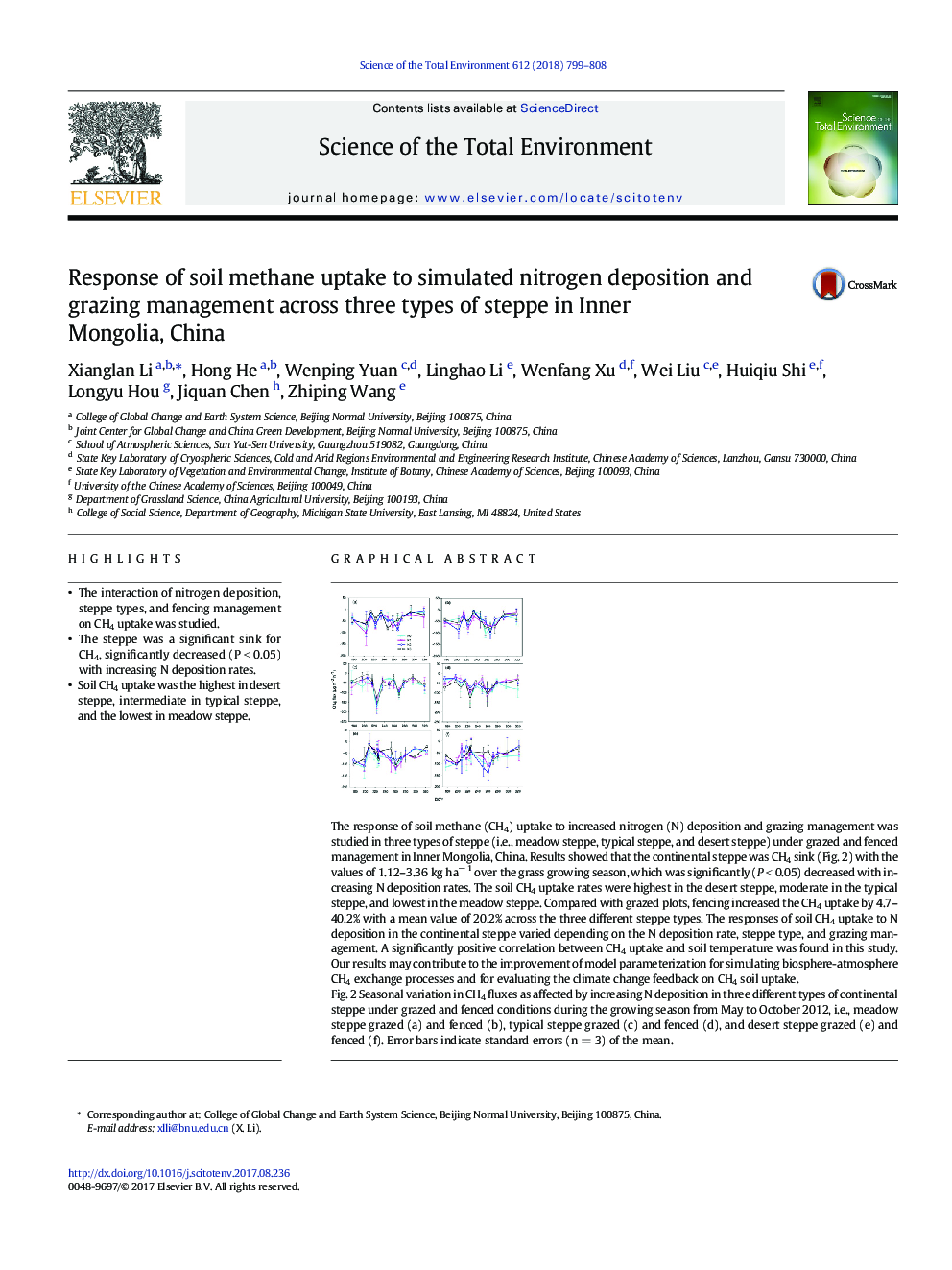| کد مقاله | کد نشریه | سال انتشار | مقاله انگلیسی | نسخه تمام متن |
|---|---|---|---|---|
| 5749935 | 1619691 | 2018 | 10 صفحه PDF | دانلود رایگان |
- The interaction of nitrogen deposition, steppe types, and fencing management on CH4 uptake was studied.
- The steppe was a significant sink for CH4, significantly decreased (PÂ <Â 0.05) with increasing N deposition rates.
- Soil CH4 uptake was the highest in desert steppe, intermediate in typical steppe, and the lowest in meadow steppe.
The response of soil methane (CH4) uptake to increased nitrogen (N) deposition and grazing management was studied in three types of steppe (i.e., meadow steppe, typical steppe, and desert steppe) in Inner Mongolia, China. The experiment was designed with four simulated N deposition rates such as 0, 50, 100, and 200 kg N haâ 1, respectively, under grazed and fenced management treatments. Results showed that the investigated steppes were significant sinks for CH4, with an uptake flux of 1.12-3.36 kg haâ 1 over the grass growing season and that the magnitude of CH4 uptake significantly (P < 0.05) decreased with increasing N deposition rates. The soil CH4 uptake rates were highest in the desert steppe, moderate in the typical steppe, and lowest in the meadow steppe. Compared with grazed plots, fencing increased the CH4 uptake by 4.7-40.2% with a mean value of 20.2% across the three different steppe types. The responses of soil CH4 uptake to N deposition in the continental steppe varied depending on the N deposition rate, steppe type, and grazing management. A significantly positive correlation between CH4 uptake and soil temperature was found in this study, whereas no significant relationship between soil moisture and CH4 uptake occurred. Our results may contribute to the improvement of model parameterization for simulating biosphere-atmosphere CH4 exchange processes and for evaluating the climate change feedback on CH4 soil uptake.
The response of soil methane (CH4) uptake to increased nitrogen (N) deposition and grazing management was studied in three types of steppe (i.e., meadow steppe, typical steppe, and desert steppe) under grazed and fenced management in Inner Mongolia, China. Results showed that the continental steppe was CH4 sink (Fig. 2) with the values of 1.12-3.36 kg haâ 1 over the grass growing season, which was significantly (P < 0.05) decreased with increasing N deposition rates. The soil CH4 uptake rates were highest in the desert steppe, moderate in the typical steppe, and lowest in the meadow steppe. Compared with grazed plots, fencing increased the CH4 uptake by 4.7-40.2% with a mean value of 20.2% across the three different steppe types. The responses of soil CH4 uptake to N deposition in the continental steppe varied depending on the N deposition rate, steppe type, and grazing management. A significantly positive correlation between CH4 uptake and soil temperature was found in this study. Our results may contribute to the improvement of model parameterization for simulating biosphere-atmosphere CH4 exchange processes and for evaluating the climate change feedback on CH4 soil uptake.Fig. 2 Seasonal variation in CH4 fluxes as affected by increasing N deposition in three different types of continental steppe under grazed and fenced conditions during the growing season from May to October 2012, i.e., meadow steppe grazed (a) and fenced (b), typical steppe grazed (c) and fenced (d), and desert steppe grazed (e) and fenced (f). Error bars indicate standard errors (n = 3) of the mean.162
Journal: Science of The Total Environment - Volume 612, 15 January 2018, Pages 799-808
